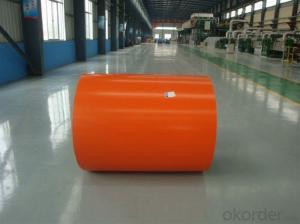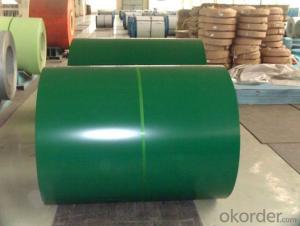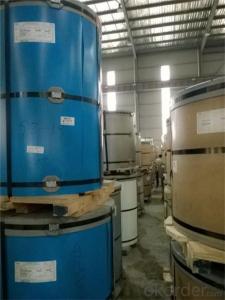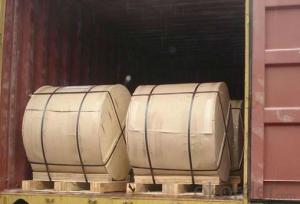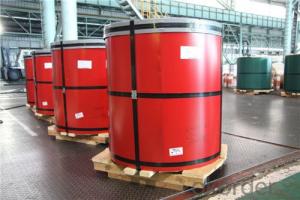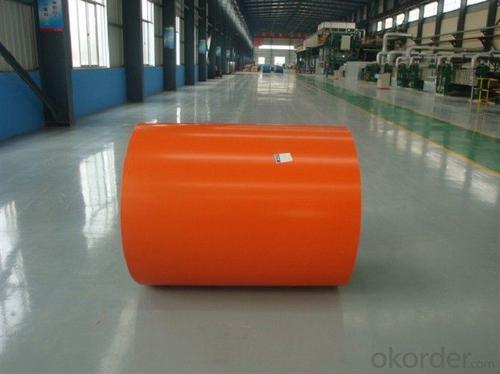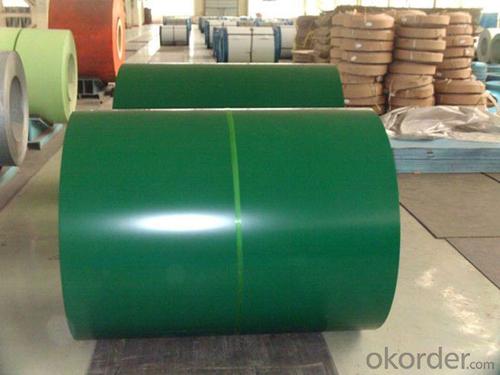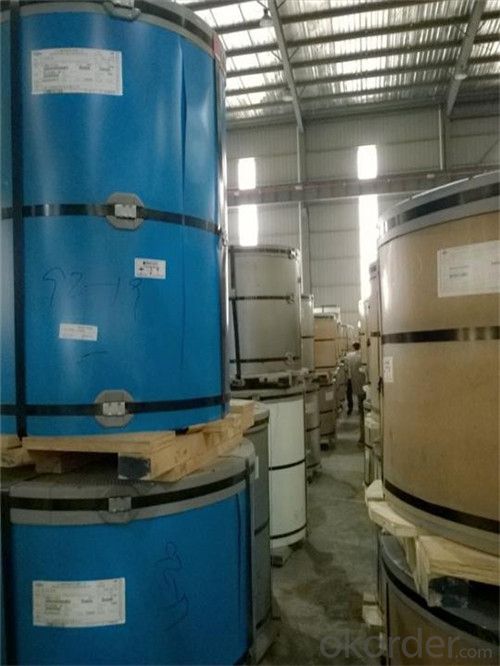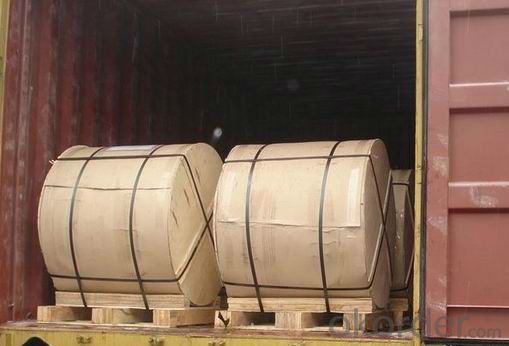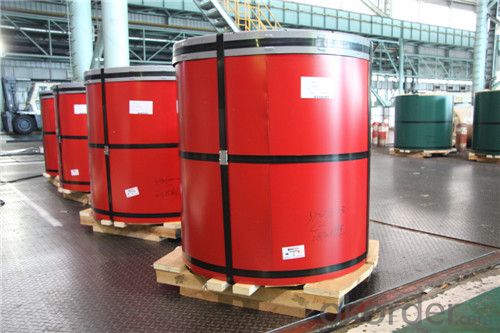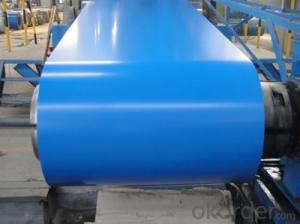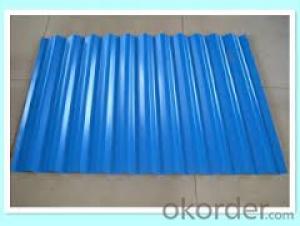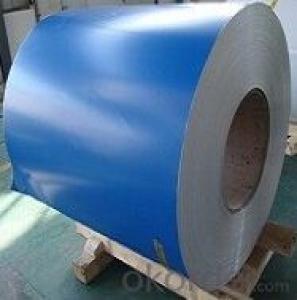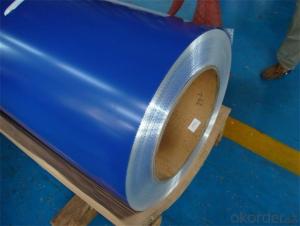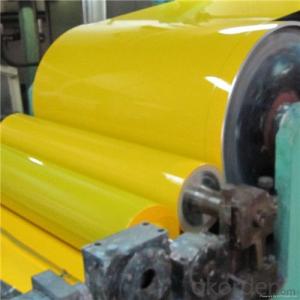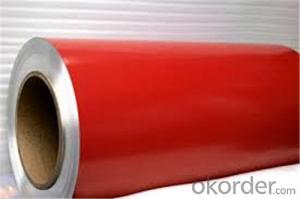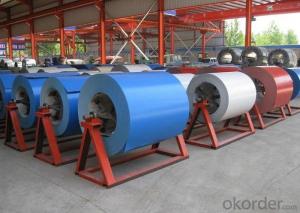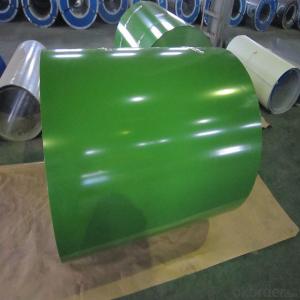CGCC Prepainted Rolled Steel Coil for Construction Roofing Construction
- Loading Port:
- Shanghai
- Payment Terms:
- TT OR LC
- Min Order Qty:
- 100 m.t.
- Supply Capability:
- 30000 m.t./month
OKorder Service Pledge
OKorder Financial Service
You Might Also Like
Structure of CGCC Prepainted Rolled Steel Coil for Construction Roofing Construction
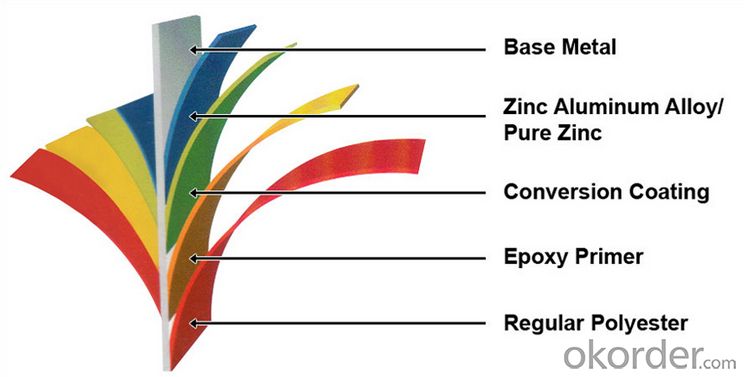
Description of CGCC Prepainted Rolled Steel Coil for Construction Roofing Construction
Laminated film50μ MPolyethyleneProtecting from scratchs and contamination (option) Top coat20μ MPolyester FluorineChemical resistance and formability Primer coat5μ M Polyester Workability, corrosion resistance and adhesion to the primer coating Chemical treatment1μ MChromateGood adhesion and corrosion resistance
Substrate0.2mm-1.2mmGI. GL, ALGI. GL, AL Back coat5± 2μ MEpoxyCorrosion resistance and adhesion to the substrate Characteristics: 20 years outdoor liability approved, Corrosion protection, Long life-time for coated color.
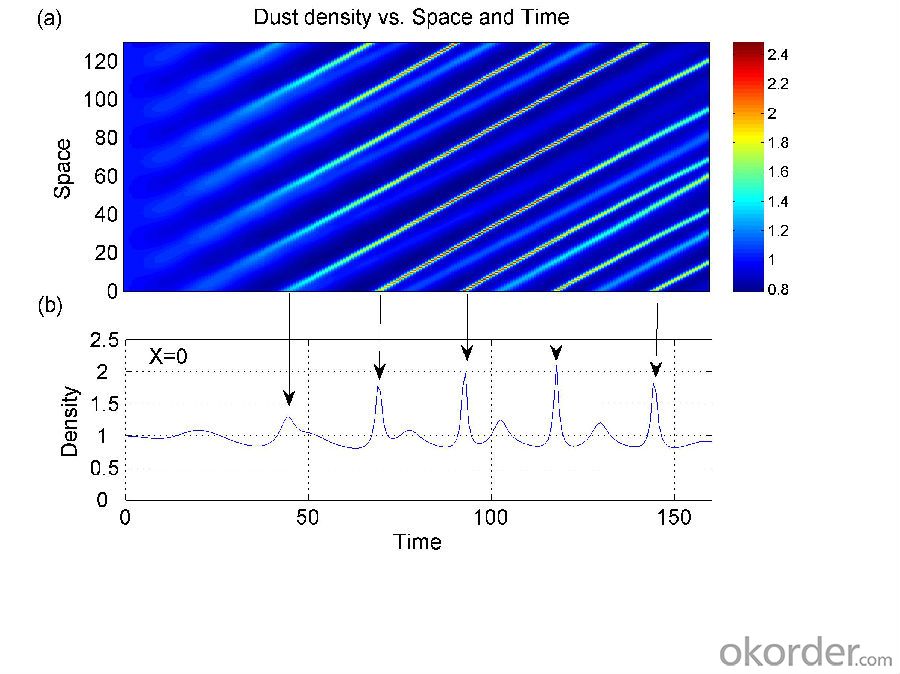 Main Feature of CGCC Prepainted Rolled Steel Coil for Construction Roofing Construction
Main Feature of CGCC Prepainted Rolled Steel Coil for Construction Roofing Construction
1) Excellent corrosion resistance: The zinc layer provides a good protection of Pre-painted Galvanizeed Steel Sheet.
2) High heat resistance: The reflective surface of the material aids in efficiently reflecting the sunlight away and in turn reducing the amount of heat transmitted. The thermal reflectivity converts into energy savings.
3) Aesthetics: Pre-Painted Galvanized steel sheet is available in plethora of patterns and multiple sizes as per the requirements that given by our customers.
4) Versatility: can be used in the various areas.
Applications of CGCC Prepainted Rolled Steel Coil for Construction Roofing Construction
Refrigerators, frozen food display cabinets, washing machines, electric ovens, vending machines, air conditioners, copiers, switchgear, instrument cabinets, electric fans, vacuum cleaners and so on.
Transport: Car ceiling, backplane, hoardings, interior trim panels, car shell, trunk panels, car dashboard, console shell, tram, train ceiling, partitions, wall, door, ships separated Swatchesdoors, furniture board, flooring, container, etc.
Sheet metal processing and furniture applications: Ventilation and heating stoves, water heaters, shell, counters, shelves, signs, wardrobe, desk, bedside cabinets, chairs, lockers, file cabinets, bookshelves.
Exact Rate As Per Your Request.
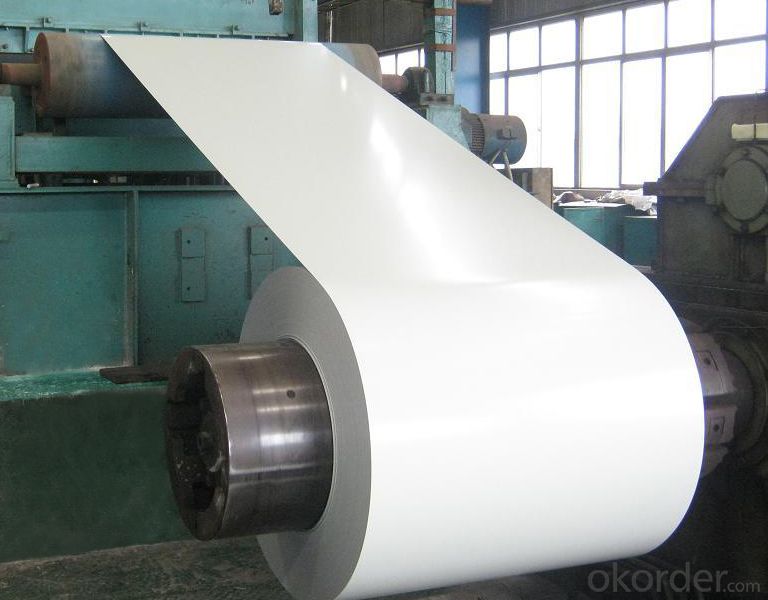
Specifications of CGCC Prepainted Rolled Steel Coil for Construction Roofing Construction
| Classified symbol | Yield Point Minimum N/mm2 | Tensile Strength Minimum | Elongation Minimum % | Application | ||||
| N/mm2 | Nominal Thickness mm (t) | |||||||
| JIS | Yogic | 0.25-0.4 | 0.4-0.6 | 0.6-1.0 | 1.0-1.6 | |||
| G3312 | specification | |||||||
| CGCC | CGCC | -205 | -270 | -20 | -21 | -24 | -24 | Commercial |
| CGCD | CGCD | --- | 270 | --- | 27 | 31 | 32 | Drawing |
| --- | CG340 | 245 | 340 | 20 | 20 | 20 | 20 | Structural |
| CGC400 | CG400 | 295 | 400 | 16 | 17 | 18 | 18 | Structural |
| CGC440 | CG440 | 335 | 440 | 14 | 15 | 16 | 18 | Structural |
| CGC490 | CG490 | 365 | 490 | 12 | 13 | 14 | 16 | Structural |
| CGC570 | CG570 | 560 | 570 | --- | --- | --- | --- | Structural |
| ASTM Designation | Yield Point Minimum | Tensile Strength Minimum | Elongation Minimum % | Application | Q/BQB 445-2004(China standard) | ASM A653/A653M | JISG 3312 | |
| ksi(MPa) | ksi(MPa) | TDC51D+Z | (CS TYPE A+Z) | CGCC | ||||
| A653(M)-99 CS TYPE A,B,C | --- | --- | --- | Commercial | TDC52D+Z | CGCD | ||
| A653(M)-99 FS | --- | --- | --- | Lock Forming | TS250GD+Z | (G250+Z) | - | |
| A653(M)-99 DS | --- | --- | --- | Drawing | TS300GS+Z | (G300+Z) | CGC 400 | |
| A653(M)-99 SS Grade33(230) | 33(230) | 45(310) | 20 | Structural | TS350GD+Z | (G350+Z) | CGC490 | |
| A653(M)-99 SS Grade37(255) | 37(255) | 52(360) | 18 | Structural | TS550GD+Z | (G550+Z) | CGC570 | |
| A653(M)-99 SS Grade40(275) | 40(275) | 55(380) | 16 | Structural | ||||
| A653(M)-99 SS Grade50(345) | 50(345) | 65(450) | 12 | Structural | ||||
| A653(M)-99 SS Grade80(550) | 80(550) | 82(570) | --- | Structural | ||||
FAQ of CGCC Prepainted Rolled Steel Coil for Construction Roofing Construction
We have organized several common questions for our clients,may help you sincerely:
1. What is your package?
Standard export packing, 4 eye bands and 4 circumferential bands in steel, galvanized metal fluted rings on inner and outer edges, galvanized metal and waterproof paper wall protection disk, galvanized metal and waterproof paper around circumferece and bore protection.
2. How Can I Get Some Sample?
We are honored to offer you sample.
3. Why choose CNBM?
1, ISO, BV, CE, SGS approved.
2, Competitive price and quality.
3, Efficient service team online for 24 hours.
4, Smooth production ability(50000tons/month) .
5, quick delivery and standard exporting package.
6, Flexible payment with T/T, L/C, Paypal, Kunlun bank, etc .
- Q: hello friends, I have some old 7.62x54r on stripper clips its nasty gunk on it can i use steel wool to glean it and still have it fire safely?
- * Yes, but I use both fine steel wool and Liquid Brasso Metal Polish on mine.* You can buy it at any Hardware and I believe Walmart carries it.* Great stuff.*
- Q: How do the sandpaper grits compare with different coarse levels of steel wool? For example, I'm finishing a homemade entertainment center, and using a tinted polyurethane, and it says to use 000 grade steel wool, but mine is #3, could I use some sanpaper instead, and what grit?
- 150 grit is standard for final sanding for poly. You could use 220 if you finish with something thinner like lacquer of if that's all you have. Even finer would work but not do much sanding.
- Q: Could someone please explain what happens when steel is heat treated and why these happenings cause the steel to become harder? Please dig down into the micro details of the crystallites but in somewhat laymen's terms. Also describe the processes which achieve these results; if you have the time. Thanks for your time and effort.
- Alright, usually whu heat you heat treat mild steel, this is because you would like it stronger than you got it. To do this you must alter the grain structure of the part or in other words, the CRYSTALLITES. Ultimately you'll end up altering the nature of the grains structure changing the tensile strength it can handle, yield strength, and even change the elongation percentage that it can tolerate under load. Heat treatment controls the rate of diffusion, and the rate of cooling within the microstructure to create these elements. Usually what they use to do this is add an element to it to make it stronger such as carbon to increase its rockwell hardness, which by the way the lower you go the harder the part can become. Heat treatment can be used in more ways than this. It can also be used to weaken the parts grain structure. This will lower the parts mechanical properties making it softer and more ductile or easier to manipulate if you have to bend it into a particular shape. Typically if you allow the part to cool after heat treatment it does go through annealing. The part will be heat treated into different stages. The first being the austenitic crystal phase which depending on how hard and strong you want it, will be at its peak. When it is cooled, it will go through a will transform to martensite which is a hard yet brittle crystalline structure. Martenised part will usually be tempered to a certain degree to improve the mechanical properties to what is needed. There is more to this and you can use the link below to read more about it.
- Q: How do steel coils compare to aluminum coils?
- Steel coils are generally stronger and more durable than aluminum coils. They have a higher tensile strength and better resistance to impact and abrasion. However, aluminum coils are lighter, more corrosion-resistant, and have better thermal conductivity. The choice between steel and aluminum coils depends on the specific application and the desired characteristics such as strength, weight, and corrosion resistance.
- Q: How are steel coils used in the manufacturing of seat structures?
- Steel coils are used in the manufacturing of seat structures as they provide strength, durability, and stability to the seats. These coils are typically used in the construction of seat springs, which offer support and comfort to the occupants. The steel coils are carefully designed and placed within the seat structure to ensure proper weight distribution and to withstand the pressure exerted on the seats during usage.
- Q: What is the difference between hot-rolled and cold-rolled steel coils?
- The main difference between hot-rolled and cold-rolled steel coils lies in the production process. Hot-rolled steel coils are made by heating the steel above its recrystallization temperature, causing it to become malleable and allowing it to be rolled into the desired shape. This process results in a thicker and less precise product with a rough surface. On the other hand, cold-rolled steel coils are made by cooling the hot-rolled steel and then passing it through rollers at room temperature. This process enhances the steel's strength, durability, and dimensional accuracy, resulting in a thinner and smoother product that is ideal for applications requiring precision.
- Q: How do steel coils contribute to sound insulation in buildings?
- Steel coils can contribute to sound insulation in buildings by absorbing and reducing sound vibrations. The coils act as barriers, preventing the transmission of sound waves and minimizing noise transfer between different areas of a building.
- Q: What are the different methods of forming steel coils into sheets?
- There are several methods of forming steel coils into sheets, each with its own advantages and applications. 1. Hot rolling: This is the most common method used to form steel coils into sheets. In this process, the steel is heated above its recrystallization temperature and then passed through a series of rollers. The rollers apply pressure to the heated steel, reducing its thickness and elongating it into a sheet. Hot rolling produces sheets with a smooth surface finish and is suitable for a wide range of applications. 2. Cold rolling: This method involves passing the steel coil through rollers at room temperature. Unlike hot rolling, cold rolling does not require heating the steel. The cold rolling process results in sheets with a higher dimensional accuracy and a smoother surface finish. Cold-rolled sheets are often used in applications where precise dimensions and a polished appearance are required, such as automotive body panels and appliances. 3. Annealing and pickling: This method involves subjecting the steel coil to a heat treatment process called annealing, followed by pickling. Annealing involves heating the steel to a specific temperature and then slowly cooling it, which helps to relieve stress and improve the material's mechanical properties. Pickling is the process of removing impurities and scale from the steel surface. These steps are typically performed before hot or cold rolling to ensure a high-quality end product. 4. Galvanizing: Galvanizing is a process that involves coating steel sheets with a layer of zinc to provide corrosion resistance. The steel coil is first cleaned and then immersed in a bath of molten zinc. The zinc adheres to the surface of the steel, forming a protective layer that prevents rust and corrosion. Galvanized sheets are commonly used in construction, automotive manufacturing, and electrical appliances. 5. Electro-galvanizing: This method is similar to galvanizing, but instead of immersing the steel coil in a bath of molten zinc, an electric current is used to deposit zinc onto the surface of the steel. Electro-galvanizing offers similar corrosion resistance to traditional galvanizing but with a thinner coating. It is often used in applications where a thinner, more lightweight sheet is desired. In summary, the different methods of forming steel coils into sheets include hot rolling, cold rolling, annealing and pickling, galvanizing, and electro-galvanizing. Each method has its own advantages and is suitable for different applications based on the required surface finish, dimensional accuracy, and corrosion resistance.
- Q: I just bought a dpms ar15 and it says if I shoot steel cases (laquer coated) or foreign ammo it voids the warranty. But before I knew this I bought 200 rounds of Russian steel cased anmo. Think I should just shoot there two hundred and not buy anymore? Some people say all they shoot is steel cased ammo and have no problemAny advice is appreciated
- Steel Case Ammo
- Q: I'm looking for steel to make knives, but don't know what to get.
- that's a hard one, right here is why. once you like a truck you do no longer want a Porche and vice versa. In different words have been one steel excels the different is unfavorable. For overallstrengthh i like 5160, for organic area retaining i like D2, O-a million and 52100 are probable the appropriate carbonsteel in area retaining. in case you like a knife with corrosion resistance then stainless is the appropriate determination. yet stainless needs to cryo dealt with to benefit the finished skill of the steel. I don'trecommendinless for any blade over 5 as a results of fact the greater desirable grain shape won't be able to take flexing and could wreck. For a heavy accountability super knife I recomend carbon steel with a differential temper as carried out good it may flex without breaking. What does all this mean? the appropriate steel is not any further effective than a decrease high quality steel if there's a deffitiancy in warmth therapy or layout. D-2 has not greater reducing potential than 440c at 57r. i do no longer use stainless in my knives as they're puzzling to warmth manage, D-2 case in point, fifty deg. in the two direction from the hardening temp (which ought to be held for minimum of 20-half-hour) can mean 2 factors Rockwell. All stainless are this type, as such maximum manufactures in no way comprehend the potetiel of the steel. right here is what i exploit, on a small knife have been i want greater effective area retaining from a greater durable temper (60r) i like O-a million, W-a million and 52100. For greater desirable knives L-6 works properly. For a survival/attempt against knife 5160 is my determination. those are not the only steels accessible, the books are full of them. solid luck.
Send your message to us
CGCC Prepainted Rolled Steel Coil for Construction Roofing Construction
- Loading Port:
- Shanghai
- Payment Terms:
- TT OR LC
- Min Order Qty:
- 100 m.t.
- Supply Capability:
- 30000 m.t./month
OKorder Service Pledge
OKorder Financial Service
Similar products
Hot products
Hot Searches
Related keywords
